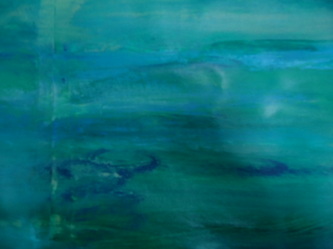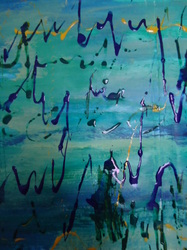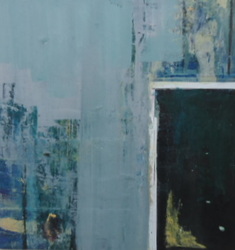|
So - never a dull moment - onwards and upwards. The next challenge is to work along with two other Stage 2 Painting students on a shared project to exhibit on the 7th November in one of the free studios. This is a very square whitewashed room. There are windows high up on one side and on the opposite wall are a couple of doors giving access to cupboards presumably. I have never opened them! There are three walls on which to hang which is convenient. One of these is panelled which could give rise to difficulties but I have chosen it for hanging my work for reasons which will be given later. We have decided to have a common starting point - 'Clare de Lune' by Debussy. Sarah - one of the other two - was working on artwork inspired by a piece of music which got me thinking. Somehow I happened when surfing the net upon Debussy and my suggestion as to the particular Clare de Lune was approved. Debussy is considered a French Impressionist painter. Clare de Lune was written in response to Paul Verlaine's poetry. He is considered a French Symbolist poet. My artwork is to take the form of eight panels representing piano keys. I found a rough estimation as to the dimensions of grand piano keys and scaled up - 9 x 54 cm a piece. They will be painted in colours taken from Whistlers Nocture series. Nocturne having the same moonlight connections as the music and poetry. Having listened to the music I have eight different 'annotations' which will be inscribed into the panels. These panels have been underpainted in yellow. Greys, greens and blues will be painted on top and the annotated symbols will be scratched through the upper layers to expose the yellow. These annotations will take the form of morse code I suppose and there will be links between the stopping point of one panel and the starting point of another in order for them to be read as a cohesive whole. The width of the panels equates with the width of the panelling in the studio. Each of the painted panels will be backed with a piece of wood so that the panel sits out - four one width, the other four slightly bigger so that they appear to be moving. This is the master plan. Unsure as to if it is going to work, which is why I was in studio today - on a Sunday, getting moving. The images below show the application of paint to create a surface in keeping with Whistler's Nocturne series. On this surface I used acrylic inks to play with the 'written' responses to the music.  The eight panels were primed with gesso and undercoats of yellow then nailed and blu-tacked precariously on the wall in order to be over-painted as one. It was important for the colours and movement to be continuous.  This image shows three preparatory pieces where I worked with oils on the far left, then acrylic with palette knife in the middle and the far right with a brush. Whistler's painting is evident in the middle section of the image. Below is my sketchbook showing how I arrived at the colours.
0 Comments
We had the first major crit of the year yesterday. The studio space was to reflect our work the best way possible. The hammer was put to good use and where nails were not brave enough to contribute, blu tack stepped in.
Two tutors came to hear what I had to say and to be introduced to the work. It seemed to go well although I need to wait until Friday to get the official feedback. I ventured a new format - a video showing the progression of the paintings from start to finish. I thought this apt given the importance of the passing of time. Here is the youtube link: http://www.youtube.com/watch?v=4rqkdDly4jk This is the title of my first project. I have been really getting into the whole depiction or reinvention of how paint manifests over time. I have long been drawn to objects and structures that are showing signs of age and wear. The paint itself goes through many colour transformations, peeling back revealing colours and coverings from years gone by. I am increasingly interested in the notion of man-made structures being left to retreat to the immediate natural environment. Land Artists fit this bill in that their structures are 'borrowed' from nature and thus retreat back to nature over time. Man's influence is transitory.
In researching I found the work of Land Artist Robert Smithson inspring along with that of John Piper, the war artist and more contempraryDan Dempster, Tony Reason and Rosamond Purcell. The latter three all either use the power of nature in order to arrive at their work or use discarded, dead items to make quite beautiful pieces. These images are derived from a tumble-down shed in Fort William. In keeping with the fact that I am attempting to depict features that have been derived over time, my work also has taken time. Layers of paint scraped back and worked over until a certain surface is arrived at. Colour relationships were borrowed from images I have collected over some time. Second year is a very busy year. Much for structured as far as I can see. I have just gone through my notebook and have found a huge amount of content by way of lectures, seminars and workshops. We have hit the ground running. All is exciting and there is a great sense of purpose.
Trying to find out what postmodernism means is another issue entirely. We are required to submit a 2000 word essay on how postmodernism and modernism affects our studio practice. A tough one to get into but on the upside by the end of it, I will, along with my contemporaries, have a far better idea of where our particular practice lies in the art world. As regards my own studio practice it is going well. I share a studio with some nine others - the number varies depending on how many full-term Stage 2 Painting students are in and how many part-time BA students come in for their allotted days. It tends to be a very focussed and calm working environment with a few breaks for shared tea/coffee and chats which is grand. My space, although not large is mine! I have a locked cabinet and a large table and three walls to hang things on. The latter being more promising in theory than in practice as the panels do not submit to either blu tack or panel pins readily. |
AuthorCarol E Duff Archives
May 2019
Categories
All
|


















 RSS Feed
RSS Feed
